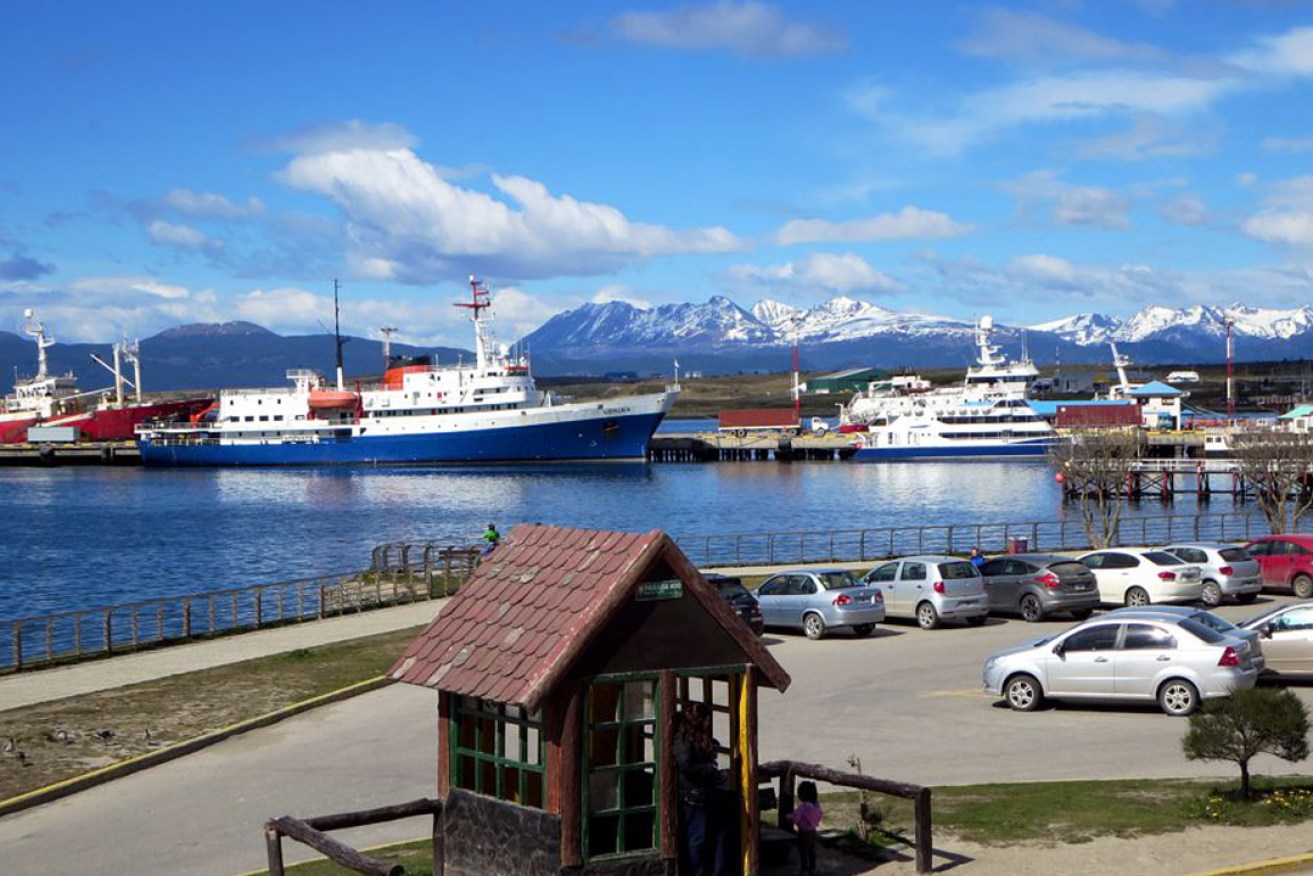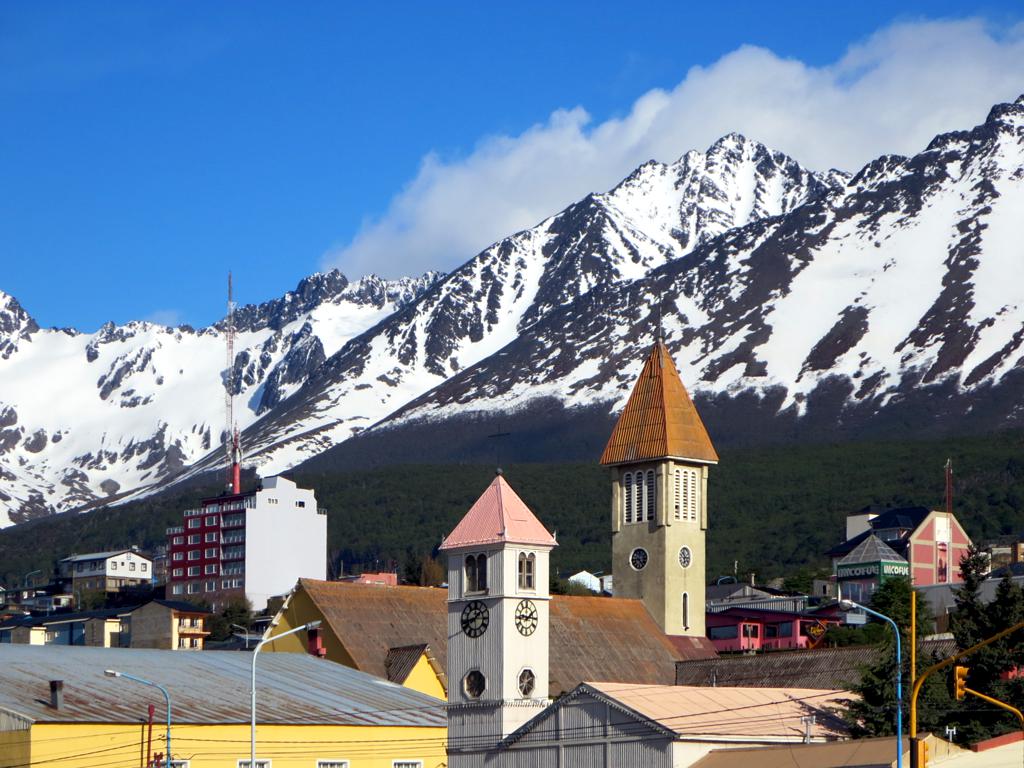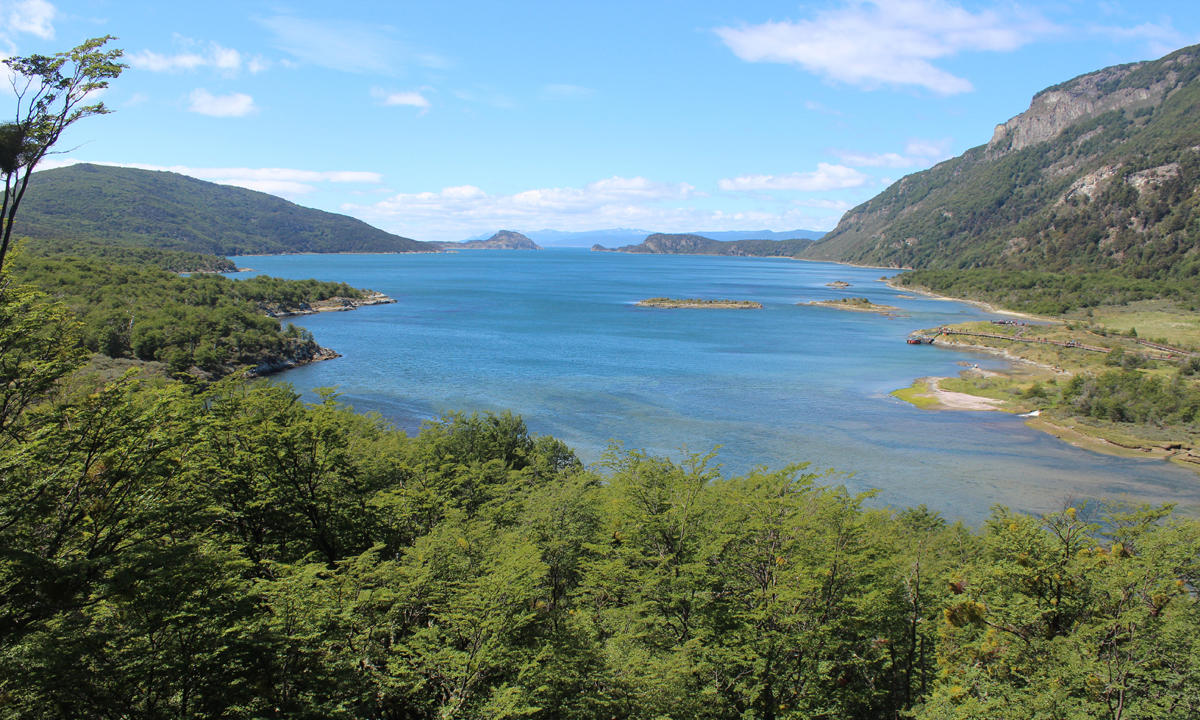The cold, confusing dreamland of Ushuaia in Argentina
I stand at one of the most famous passenger ports in the world, looking out to sea. I’m feeling inspired by the freezing gulf before me, yet a little demoralised by this place. It’s the end of the world. Who wouldn’t be?

The tourist pier at Ushuaia, Argentina, with the snowcapped mountains of Tierra del Fuego in the background. Photo: David Stanley / flickr
A sign next to me welcomes me in Spanish to Ushuaia. “Where there are dreams, there’s sun,” it reads.
Sun and dreams are obviously a commodity in the world’s southernmost town, which sits on the bottom tip of Argentina, battered by Patagonia’s bitter winds.
I imagine lots of dreaming goes on here. Across the water, 1000km across the choppy Drake Passage, lies the world’s seventh continent, a pristine and beautiful world of icebergs and glaciers that many long to see but most never do. That includes the locals – many will never earn enough money.
Ushuaia is a haphazard town; a steep hill stuffed with confused architecture. There’s mock Alpine, ’70s boxes and hastily constructed wooden homes. Hidden away beyond the southern stretch of the Andes, which watch over the town, it feels like this place has grown without any supervision from the rest of the world.

Church towers point to the mountains surrounding Glaciar Martial at Ushuaia. Photo: David Stanley / flickr
It took a long time for anyone to want to come here at all. Perhaps it was the cold, the lack of resources, the “fearsome savages”, or maybe just a fear of falling off the map. In fact, this far reach of the Americas was one of the last parts of the world to be mapped and charted.
The first permanent settlers to Ushuaia – which means “bay that enters to the west” in the local indigenous language – were English missionaries who arrived in the second half of the 19th century determined to evangelise the “savage” tribes.
The next big influx of people were inmates, sent to the national prison built in the first half of the 20th century. At the time of its operation, the 600 or so prisoners dwarfed the town’s population, which made Argentines somewhat afraid of this “Siberia of the south”. In 1947, the prison closed.
“My mother was born in Ushuaia that year,” Isabel, our local Chimu Adventures host, tells us. “The population then was 1500. By the year I was born, 1977, it had risen to over 6000.
“Today, my own daughter is growing up in a very different place. We now have 80,000 here.”
Ushuaia’s growth rate is staggering. A steep rise in Antarctic tourism is partly to blame. Almost 40,000 tourists per year visit the icy continent, many arriving by ship from the port town.
But the Argentine government has also encouraged people to move here, luring industries to Ushuaia in the ’80s with generous benefits that companies passed on in good salaries. Very quickly the town started to pump out TV sets, air conditioners and smartphones to the domestic market.
“There wasn’t much planning,” Isabel tells us. “People arrived and built a house wherever they could.
“You can see the slanted roofs for the snow but otherwise it’s very hotchpotch.”
I love that the word “hotchpotch” has been necessary to her English vocabulary set. And she’s right. Driving around, it feels like homes and hotels were constructed almost in desperation, without love or care. Colours and styles clash like a fancy dress party. So unloved for so long.
Factories and warehouses border the town, keeping at bay a sparse landscape. Trees have long since made way for cattle grazing, houses and heating.

Just beyond the haphazard town of Ushuaia likes a pristine natural environment. Photo: Caroline Berdon / AAP
But just 20 minutes after heading north from Ushuaia, my soul starts to warm. Man-made becomes nature. Chaos becomes beauty. We enter a stunning landscape of mountains, valleys, lakes, rivers and subantarctic beech forests that covers the southern tip of the Argentinian Andres: Tierra del Fuego National Park.
Today, a mild November day, dandelions and buttercups sway gently among the grasses as woodpeckers attack the trees and condors fly overhead. Even on summer days, the temperature won’t rise above 10 degrees Celsius here. In winter, snow is abundant.
To modern eyes, this place seems beautiful but hostile; the warmth of its name, Land of the Fire, at odds with the frigid reality. It’s hard to imagine the early Yamana people integrating so effectively with this environment 10,000 years ago.
Coming from Australia, where the bush hums with life, this wilderness feels empty. There are few insects, no reptiles, no amphibians, and no mosquitoes, ants or cockroaches.
Bacteria, germs and viruses find it hard to thrive in these temperatures, too. Children who grow up in Tierra del Fuego often get battered by diseases when they head north. They never get to witness lightning storms, either; there’s no clash of warm air this far south.
From the window of our bus heading back into town, I gaze at the suburban homes on Ushuaia’s outskirts. Despite the spacious, pristine environment on their doorstep, most of the gardens are small and cluttered. Each one boasts a cylindrical tank with a chimney – a chulengo.
“They’re barbecue drums,” explains Isabel. We’re in Argentina after all. How else would locals protect their basking meat from the harsh Patagonian westerlies?
“We get together with family every Sunday for asado,” she says. “Barbecue is a must on Sunday, even in winter.”
Isabel loves the town where she was born and bred, and she welcomes the tourists who pass through. She must stay here during the summer Antarctic season, but locals who don’t work in tourism often head north at this time, to avoid the crowds and catch some sun.
She speaks warmly about the town’s cold winter mornings, when the sun doesn’t rise until 10am.
“We get up early to start the car, then we go back in, shower and have breakfast,” she says. “The car will still be there. Tierra del Fuego Island is a small, safe place.”
The far southern sun reignites the dreams, day after day. And the dreams fuel a warmth and togetherness in this harsh little town at the bottom of the world.
Getting there: Qantas, Latam and Air New Zealand fly from the east coast of Australia to Santiago and Buenos Aires, where you can connect to Ushuaia.
Staying there: Ushuaia has hotels for every budget but if you’re after luxury and views, Arakur is your pick. An unmissable green lodge on top of the hill, it’s a place where you can relax in a hot, outdoor infinity pool while watching Antarctica ships come and go from port. Rooms from $US350 ($A476) per night.
Playing there: Ushuaia is a small and easy town to walk around. Don’t miss the Maritime Museum of Ushuaia, located in the old prison.
The food is good here, with seafood the star. Try the southern king crab, southern sea bass and local trout. The Fuegian lamb is also a specialty.
Tours to Tierra del Fuego National Park of varying duration can be organised through Chimu Adventures; price are dependent on season and availability.
The subantarctic summer season runs between November and March, when the days are long and temperatures are cool but comfortable.
The writer travelled as a guest of Chimu Adventures.
-AAP




